From 'fungi tiles' to S$400 cooling vests: How can Singapore keep its cool as temperatures rise?
As record-breaking temperatures strain daily life here and across the globe, Singapore is exploring innovations in design and technology to build long-term heat resilience at an individual and infrastructural level.
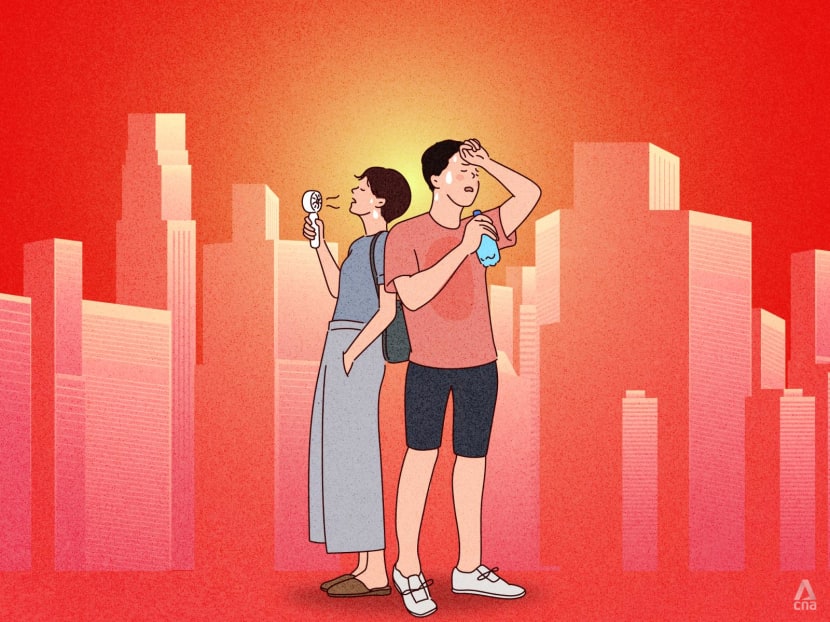
In Singapore, 2024 was the island's joint warmest year on record, tied with 2019 and 2016. (Illustration: CNA/Samuel Woo)

This audio is generated by an AI tool.
Singaporean teacher Nicole Yao and her daughter are no strangers to the hot weather common to their homeland. But a family outing to wildlife park Rainforest Wild Asia in April ended in tears, as the six-year-old girl wilted under the scorching sun.
Even their usual cooling aids – a portable fan and umbrella – offered them little relief on that particularly hot day, Ms Yao, 39, said.
"I was very surprised because (my daughter) was a girl who frequented the zoo, Bird Paradise and beach, so I thought she would be okay with the heat. Yet she cried that day because the heat was unbearable," Ms Yao recalled of the 33°C day.
As a teacher in a secondary school, where most classrooms are not air-conditioned, Ms Yao has observed that most students and teachers also rely on personal solutions, such as handheld portable fans, to manage the heat.
"The issue is that some students, especially those from low-income families, may not be able to afford portable fans. When I suggested powdered body wipes or cooling body wipes, some students also said they can't afford the extra costs to buy these wipes," she said.
Even as Singaporeans are looking for the most efficient ways to beat the heat, what with record-breaking temperatures worldwide, a bigger question looms: Can individual effort truly make a difference in how we stay cool?
Sweltering days and warm nights are nothing new in Singapore, but they are gradually intensifying and reflect a broader global trend of rising heat, from record-breaking temperatures in South Korea to wildfires in Spain, France and the United States.
A joint report by the World Health Organization (WHO) and the World Meteorological Organization (WMO), released on Aug 22, warned that heat stress is already harming the health and livelihoods of billions of workers worldwide.
WMO's services division senior director Johan Stander said: "We must face up to the future of extreme heat. It's a reality for many: a case of adapt or die."
In Singapore, 2024 was the island's joint warmest year on record, tied with 2019 and 2016. All the months in 2024 recorded temperatures that were equal to or above their respective long-term averages.
Even before then, as the mercury was climbing, the National Environmental Agency began a heat stress advisory service in July 2023 to help people gauge heat-stress risks during outdoor activities.
Associate Professor Jason Lee, director of the Heat Resilience and Performance Centre at the National University of Singapore (NUS) Yong Loo Lin School of Medicine, pointed to Singapore's third national climate change study, which projected that average daily mean temperatures could rise by as much as 5°C by 2100. In 2024, Singapore's annual average temperature was 28.4°C.
By the end of the century, warm nights could also increase from 76 nights a year at present to every night, he added.
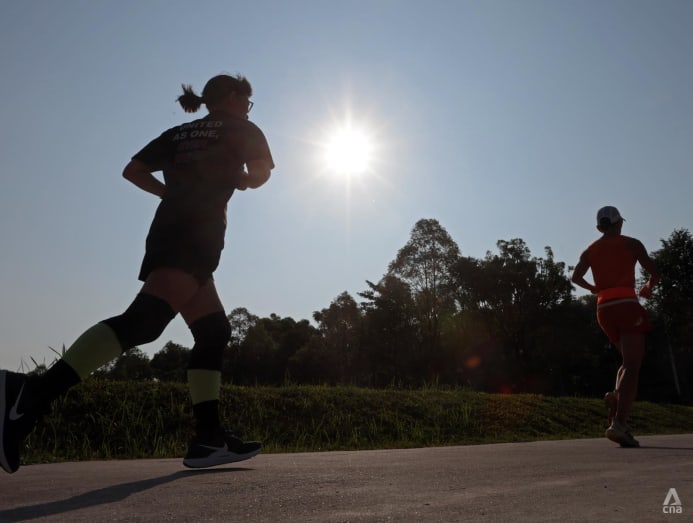
It might be easy enough to dash into an air-conditioned space to cool down or switch on an extra fan when one is feeling the heat, but such quick fixes drive up energy consumption and greenhouse gas emissions, ultimately worsening the very problem from which people are trying to escape.
The challenge, experts said, is not to avoid the heat but to adapt to it. This requires changes both in infrastructure and in the choices that people make every day.
In Singapore, scientists, urban planners and ordinary residents are exploring new ways to cope, which include rethinking how buildings are designed and experimenting with technologies that can ease the strain of heat stress on our bodies.
From a tile made out of fungi and bamboo shavings to a cooling vest designed for athletes and outdoor workers exposed to high temperatures, CNA TODAY takes a look at some of the innovations – and the obstacles in the way of their implementation – as Singapore gears up for life in a hotter world.
DESIGNS INSPIRED BY NATURE
Since heat hacks such as turning up the air-conditioning are not sustainable, the real long-term solution lies in how we design and build our cities, experts said.
Some of the most promising solutions are being tested in laboratories today and are reflected in how developers shape malls, offices and public spaces across Singapore.
For example, a team of scientists from Nanyang Technological University (NTU) and BioSEA, an ecology and biomimicry design firm, are working on an idea for cooling buildings: "fungi tiles" that have the texture of elephant skin.
The tiles are made from mycelium, the root network of fungi.
Using strains of mycelium from oyster and Lingzhi mushrooms, the mycelium is grown together with a mixture of bamboo shavings collected from a furniture shop, oats and water, then packed into a hexagonal mould textured to resemble elephant skin.
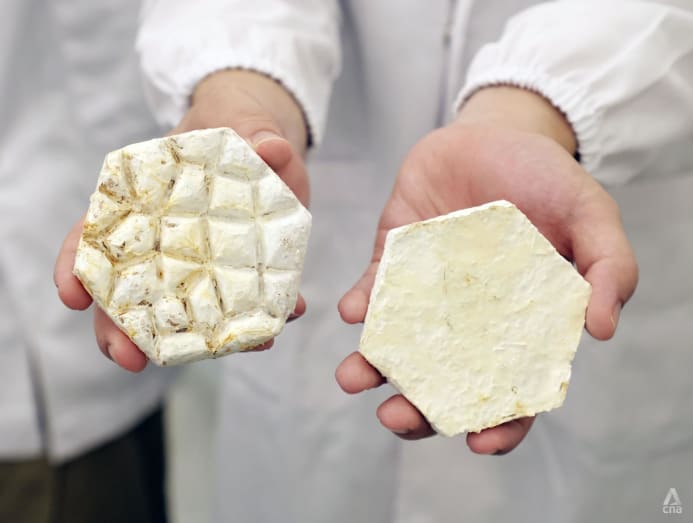
The tiles are designed by Associate Professor Hortense Le Ferrand from NTU, BioSEA's Dr Anuj Jain, as well as Dr Teoh Jia Heng and Mr Eugene Soh, both NTU researchers.
Mr Soh said: "How elephants cool themselves is that they have a lot of grooves and wrinkles in their skin, which creates these air channels that help to increase surface area, and that helps them to release all the heat that is trapped.
"You also see elephants spraying themselves with water, so they are also trapping these water droplets within these grooves and wrinkles, which also helps with evaporative cooling."
Dr Teoh said the "fungi tiles" have a circular life cycle because they can biodegrade or be reused to grow new composites.
This makes the tiles a potential sustainable alternative to thermal insulation made from polystyrene, a material commonly used in buildings today and which is incinerated or ends up in landfills once discarded.
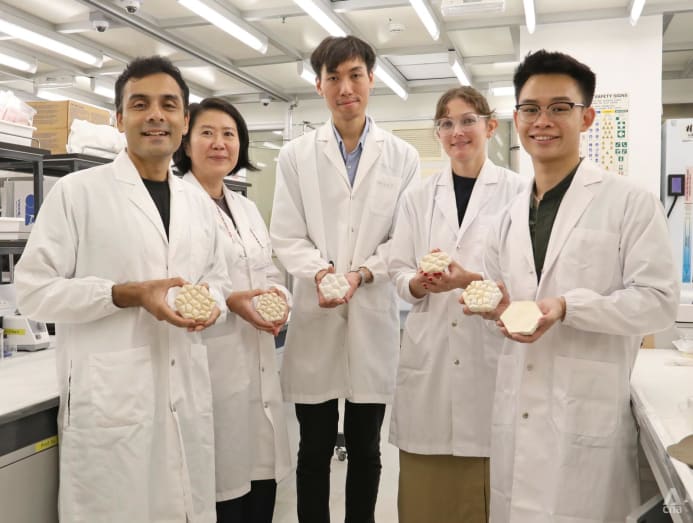
Others are already deploying cutting-edge technology to make Singapore's built environment greener.
Industrial master planner and developer JTC said that its estates' structures are planned to be naturally cooler, thereby lowering reliance on air-conditioning, cutting energy costs and reducing the estates' overall carbon footprint.
In the layout for the Punggol Digital District, for example, JTC used advanced computational simulations to model wind flow and solar radiation. It then oriented buildings to maximise natural ventilation and minimise solar heat gain.
Buildings there are predominantly oriented on a north-south axis, and many are elevated at ground level to create naturally ventilated, shaded public spaces, it added.
The Punggol Digital District, slated to be fully completed by 2026, also includes sensor-driven ventilation, using high-volume, low-speed fans in public areas that are automatically activated by weather sensors, thus operating only when needed.
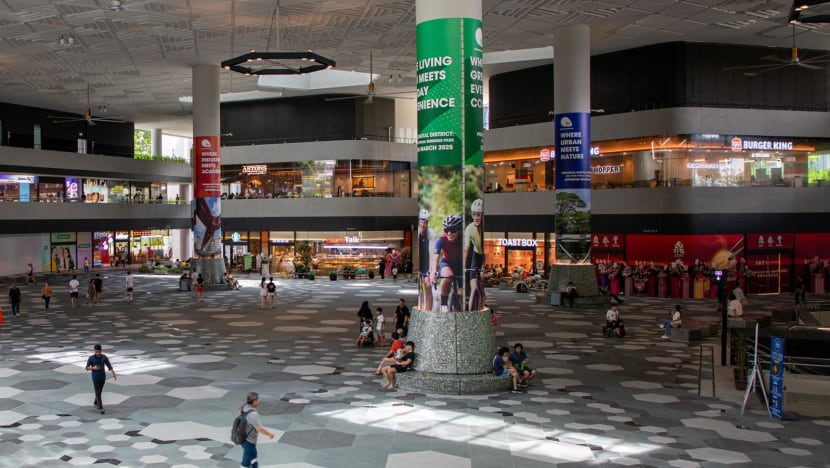
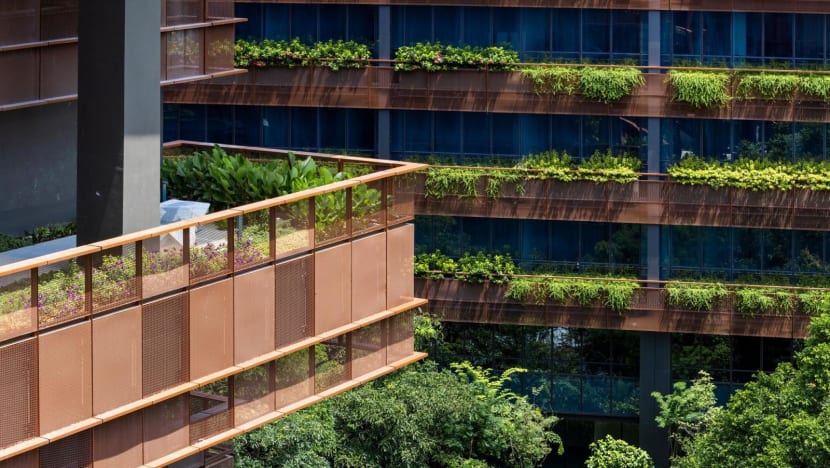
Over at the Jurong Innovation District, the nine-building industrial park at CleanTech Three, also master-planned and designed by JTC, has 25 terrace gardens and 11 communal rooftop gardens.
Mr Praveen Hassan Chandrashekar, Surbana Jurong Group's director of sustainability and resilience, said that the urban consulting firm had set out to minimise direct solar radiation through the facade and roof when designing its new campus.
The result is the campus' inverted stepped-pyramid form, designed to shade itself while maximising daylight. More than 60 per cent of its building surface faces the north-south direction, reducing east-west sun exposure, while its atrium roof uses triple-layer ethylene tetrafluoroethylene, a fluorine-based plastic material that filters ultraviolet rays and cuts solar radiation.
Beyond "passive" design, the campus also uses "active" technology in its heat resilience efforts, such as one of Singapore’s largest underfloor air distribution systems.
The distribution system delivers low-velocity air only to the occupied zone, which maintains a temperature of around 26°C and allows warm air to rise in the unoccupied areas of the atrium higher up, Mr Praveen added.
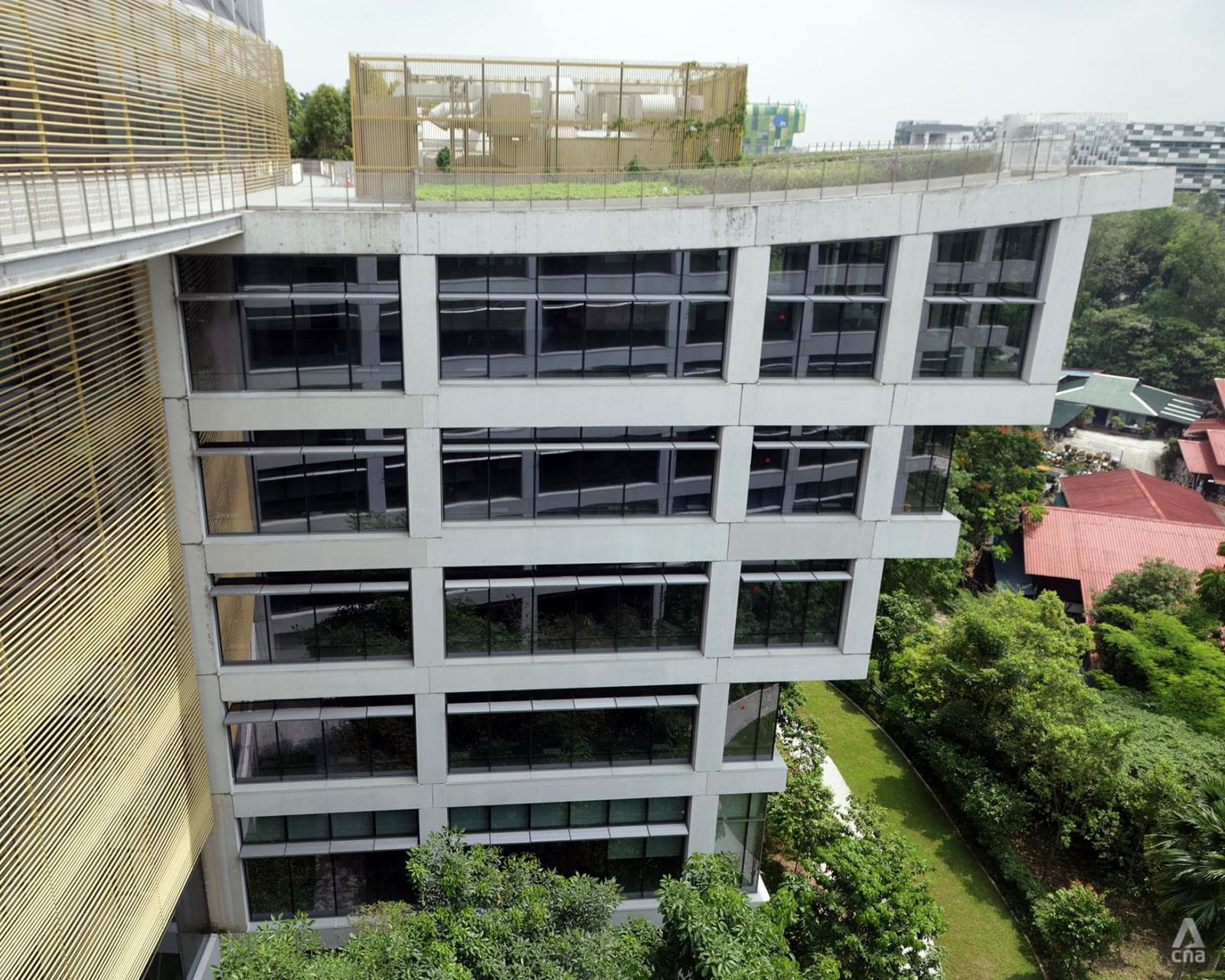
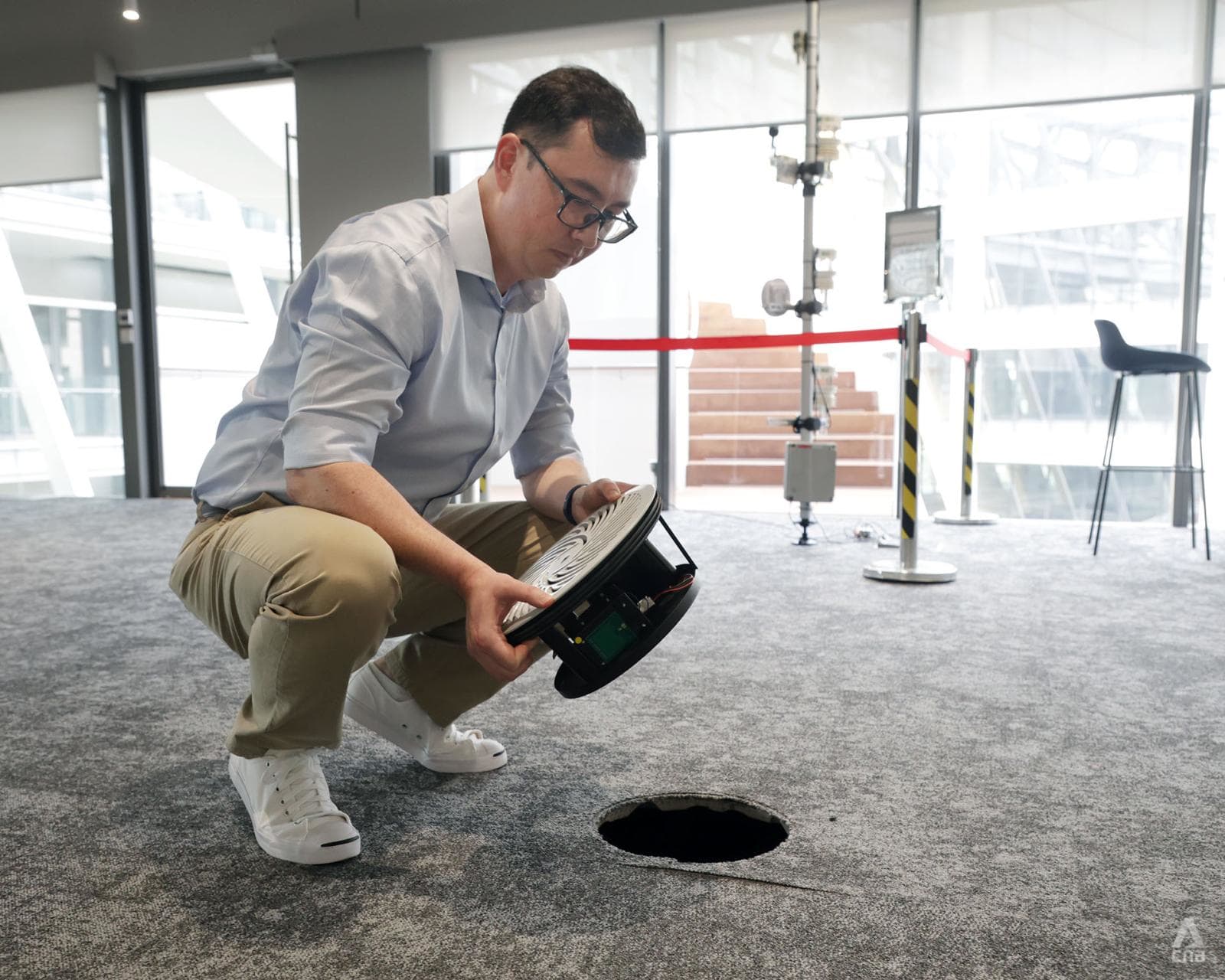
For Mr Chew Peet Mun, managing director of CapitaLand Development, heat resilience should be viewed as a "baseline principle" for urban development instead of a "design add-on".
A hallmark of the properties that the real estate company develops under CapitaLand entities is the sky terraces and vertical greenery, such as the spiralling allotment gardens at residential development One Pearl Bank in Outram.
Its Raffles Place skyscraper CapitaSpring boasts a 35m-high green oasis and rooftop sky garden, while 55 per cent of the CapitaGreen office building perimeter has a double-skin facade and greenery.
This double-skin facade combines high-performance glass and greenery to reduce the energy required for cooling while allowing ample daylight into the building with minimal glare, Mr Chew said.
Geneo at Science Park 1, a more recent project by CapitaLand Development, includes a 3,000 sq m, all-weather plaza connected to Kent Ridge MRT Station. The plaza is made out of mass-engineered timber, a low-carbon material, and combines shading strategies, greenery and naturally ventilated ground floors to keep visitors comfortably cool throughout the day.
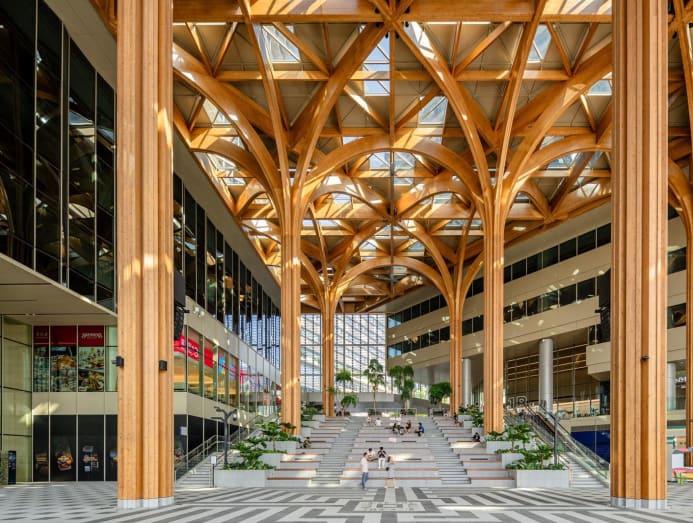
LIMITS IN REDESIGNING A HUMID CITY
For all the promise of bold new infrastructure, though, these innovations are not without their trade-offs, which include their high costs. Regulatory hurdles and the challenges posed by Singapore's humid climate are the other obstacles.
In 2024, Singapore ranked 19th out of 30 cities in the Savills Heat Resilience Index. Helsinki, Finland's capital city, came in first and Copenhagen in Denmark was ranked second. The two Nordic cities benefit from rare incidents of extreme temperature and progressive environmental and governance policies.
Mr Tony Chan, the planning business leader in Southeast Asia for built environment consultancy Arup, said that Singaporean companies are increasingly acknowledging the risks and impact of rising urban heat.
However, Singapore faces several structural challenges when it comes to designing for heat resilience, he added.
The country's dense urban form creates an urban heat island effect, a phenomenon where more built-up and densely populated areas are warmer than rural areas.
Singapore's high urban density limits its ability to integrate wind corridors, passive cooling zones and more green spaces and parks into its landscape, especially in higher-density areas such as Orchard Road and Tanjong Pagar, Mr Chan said.
Structural limitations and heritage requirements also pose a challenge to retrofitting older buildings with external shading, green facades or ventilation enhancements, he added.
Singapore's climate constrains the effectiveness of certain solutions as well.
Assoc Prof Le Ferrand from NTU said that the tropical climate limits the durability of the mycelium or fungi tiles that she and her fellow researchers are developing in the lab, for example.
"Our material is entirely biodegradable. We have done tests such as putting the tile on a wall outside in the rain. Singapore is so hot and humid, so the tiles last a few months, but then they start to degrade and become something else," she added.
The team anticipated that there would be inertia or slowness in adopting these mycelium tiles as an alternative to the insulation materials commonly used today, which have well-established supply chains.
"All the polystyrene things that we want to replace are very, very cheap, so that's a big disadvantage, because we cannot say that our material will be as cheap," Assoc Prof Le Ferrand said.
She also said that in Europe, high taxes are placed on plastics, thus incentivising companies to turn to more sustainable alternatives.
Each mycelium tile, which takes three to four weeks to grow, costs around S$9.25 to produce, though producing in larger quantities could bring costs down further.
By comparison, a polystyrene tile in the market retails for around S$5.
Agreeing, Mr Chan from Arup said that developers may not prioritise thermal resilience features if they do not gain directly from long-term energy savings, which will benefit tenants or future owners more.
"Many businesses still see heat as a 'comfort' issue rather than a business risk, so it is not internalised into risk registers or capital expenditure planning," he added.
Still, the NTU scientists creating the mycelium tiles are not daunted and plan to explore options, such as potentially developing a sustainable rainproof coating that could expand the longevity of the tiles outdoors.
The team collaborated with Singapore startup Mykilio to scale up the size of the mycelium tiles and successfully fabricated 21 30-cm large tiles that are now installed on a sheltered wall for testing. The team is observing the thermal performance of these tiles and understanding public perception of this new material.
"Just coming up with the design and creating the tile in the initial phase was very exciting. I think there is promise and potential and hopefully, we can find the right pathway that will be able to help (build) a more heat-resilient Singapore," Mr Soh from NTU said.
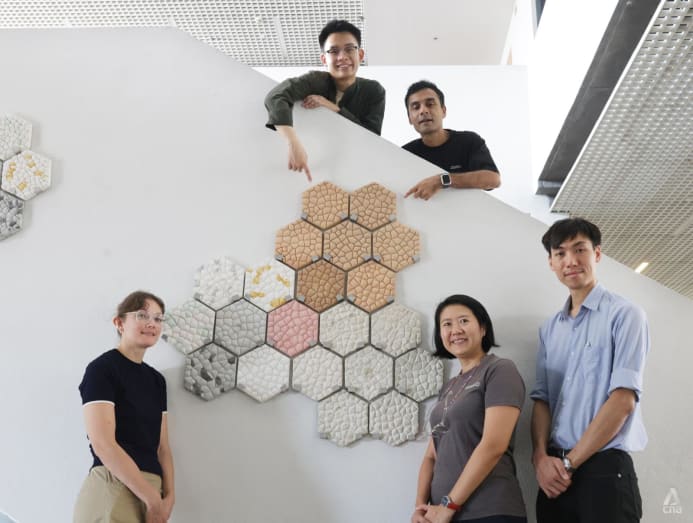
Mr Chew from CapitaLand Development acknowledged that every innovation comes with trade-offs.
"Vertical greenery, high-performance facades and full-floor sky terraces may require higher upfront investment and careful maintenance planning to ensure operating costs remain reasonable."
There are also regulatory hurdles.
For instance, CapitaLand Development had to factor in extra time when building its condominium complex LyndenWoods in Singapore Science Park, because it had to consult the Urban Redevelopment Authority over the sky terraces that were part of the design.
However, once built, these features have shown results. At the recently revamped CQ@Clarke Quay, green elements have contributed to the building achieving energy savings of 1.03 million kilowatt-hour yearly – around the annual electricity consumption of about 240 four-room public housing units.
Mr Praveen from Surbana Jurong Group said that passive design strategies such as high-performance glazing, extensive greenery and shading devices do require higher capital expenditure than conventional approaches, but he agreed that the long-term benefits outweigh the initial costs.
"Tenants and workers have responded positively to greenery and biophilic features, noting enhanced well-being and usability of outdoor spaces. Visitors frequently highlight the comfort of the tropical gardens and other common social areas, which remain thermally comfortable yet energy efficient," he added.
HOW SINGAPOREANS KEEP COOL
Although infrastructural changes can shape Singapore's long-term heat resilience, many large-scale innovations may still be years away from mainstream adoption or remain confined to specific estates.
In the meantime, coping with the heat for many Singaporeans comes down to day-to-day choices and consumer-level solutions.
Dr Fabian Lim, a pioneer in thermoregulation and heat injury research in Singapore, said that individual behaviour "forms the foundation of heat resilience", which is further enhanced by the availability of suitable infrastructure and technologies.
The senior lecturer at NTU's Lee Kong Chian School of Medicine suggested behavioural strategies to cope with hot weather conditions, including modifying one's lifestyle to include more indoor activities during hot spells.
However, he noted that some solutions such as the use of an electric fan alone may not be effective for body cooling when air temperature is near, or higher than, the skin temperature of about 36°C.
For Ms Yao the teacher, one of the best gifts she has ever received from her husband is a neck fan that cost close to $300.
"It really feels like a lifesaver. It blows cool air out and it helps to bring down the temperature a lot, but it is expensive. The price tag makes people hesitant about splurging on it," she said.
Others have turned to modifying their homes. Senior business analyst Ye Xin, 36, said that the S$750 she spent on installing solar film on her window panels at home has been a "game-changer".
"It's a one-time expense that pays off over the long run as long as you stay in the house." She added that the solar film has successfully warded against ultraviolet rays, reducing heat and glare, and she now often returns to a comfortably cool space at home.
Ms Ye never leaves home without a portable handheld fan these days, and increasingly prefers packing food and eating in the air-conditioned office during lunch breaks.
For one Singaporean firm, more advanced personal cooling solutions originally developed for medical emergencies are now being adapted for everyday use.
Global Healthcare SG has developed cooling products for pre-hospital heatstroke treatment that are now being used by the Singapore Armed Forces and hospitals here.
Its managing director Cheng Keng Liang said the system uses its proprietary cooling medium HypoCarbon, a carbon-based phase change material that conducts heat up to 15 times better than ice.
The firm launched the ArcticCore Vest Hydro in April this year. It is a lightweight vest retailing at S$472 and geared towards outdoor workers facing prolonged heat exposure, athletes or everyday use.
The wearer inserts frozen HypoCarbon pads, which can be prepared the night before in a standard freezer, into designated pockets, which can provide up to three hours of cooling.
Since its debut, orders have come from around the world, though consumer uptake in Singapore has been slower. Mr Cheng attributed this to a cultural reliance on air-conditioning as the default way to manage heat discomfort, as well as the tendency of some companies to place greater trust in American brands.
"Although climate change is expected to exacerbate heat-related health risks, the market for cooling solutions remains in a growth phase.
"Our goal is to bridge the gap between medical-grade innovation and everyday usability, helping vulnerable and high-risk individuals adapt more safely to rising temperatures," Mr Cheng said.
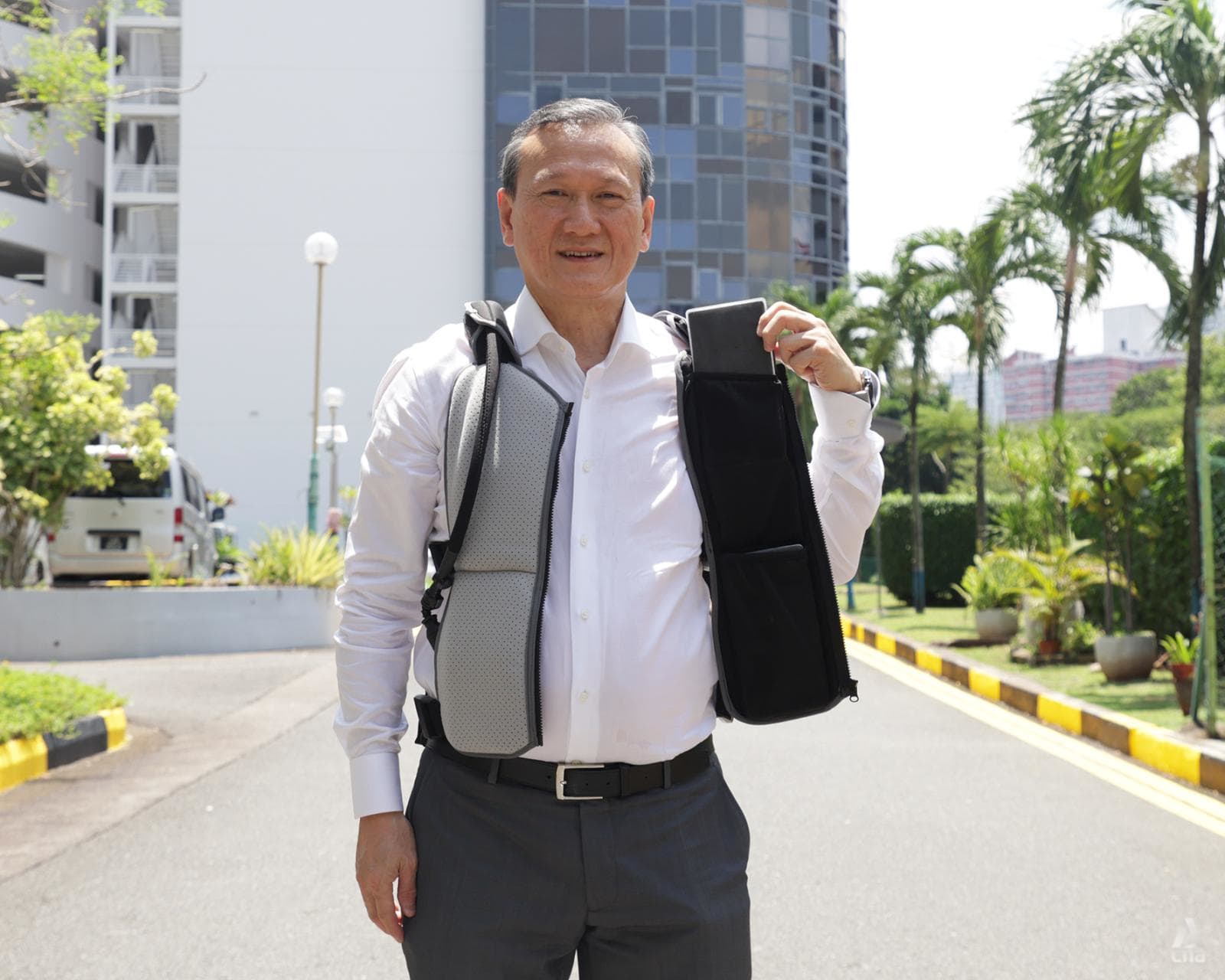
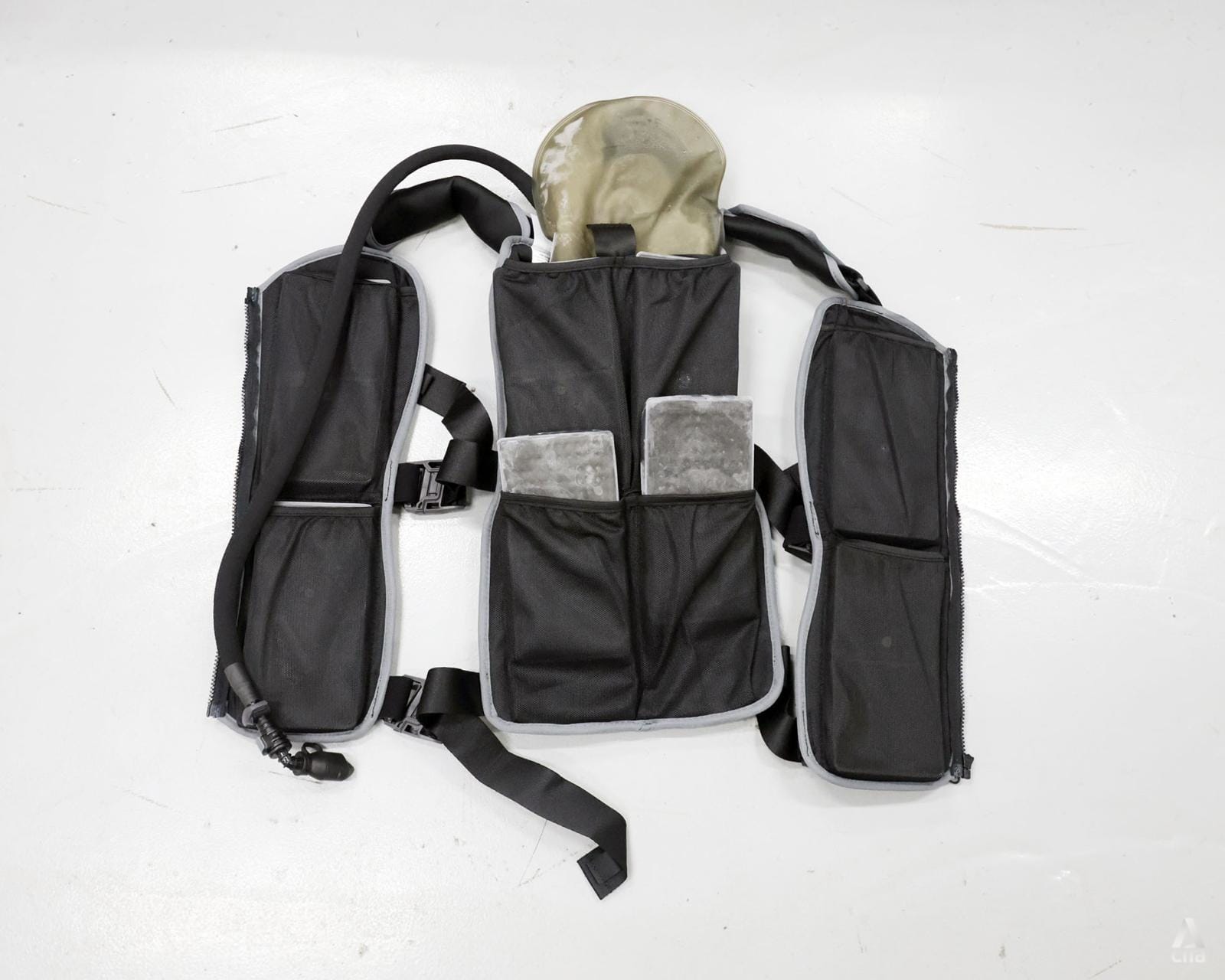
For businesses that conduct work outdoors, the hotter weather is already a pressing issue.
Mr Jonathan Chang, managing director of Sharp Win Packaging, said that rising heat has affected his employees working in semi-outdoor environments handling wooden pallets and crates.
His firm has set up more fans and improved ventilation systems in production areas, in line with the Ministry of Manpower's workplace safety guidelines on heat stress.
There are interval breaks during the day and he is now also exploring providing staff members with lighter, breathable personal protective equipment better suited for tropical climates.
"Safeguarding our employees is our top priority, and we view climate change as a real operational challenge that requires continuous adaptation to maintain both worker safety and productivity," Mr Chang said.
He also said that government support in subsidising heat mitigation technologies and promoting best practices would make a difference.
Agreeing, Assoc Prof Lee from NUS noted that the government has already made some efforts to respond to the risk of heat, including issuing heat-stress advisories, as well as putting in place workplace safety regulations, a coordinated inter-agency task force and a heatwave response plan.
But more could be done to address the hyper-contextualised needs of each sector, such as curating heat advisories based on the sector's demands and capacity to respond, he said.
WHAT THE GOVERNMENT SAYS ABOUT THE HEAT
In response to CNA TODAY's queries, the Ministry of Sustainability and the Environment (MSE) said that heat resilience is an important part of Singapore's national adaptation plan to continue thriving in "increasing yet uncertain climate risks".
"Very hot days and warm nights will be the new normal by end-century," the ministry stated.
"Generally, rising temperatures not only result in poorer thermal comfort, but also increase the risk of heat-related illnesses such as heat stress and heat exhaustion. Furthermore, heat stress also has economic and social costs, as outdoor activities may be disrupted."
Interventions for heat could be specific to the time, day and person involved. MSE said that individuals can best protect themselves by:
- Adjusting behaviour according to prevailing heat stress levels, which can be checked through the MyENV mobile application
- Reducing leisure outdoor activities and taking more breaks indoors or under shade
- Drinking fluids to stay hydrated and monitoring for early signs and symptoms of heat-related illness
- Adopting cooling strategies such as sponging and immersing arms or feet in cold water and keeping indoor or sheltered spaces cool through the use of electric fans
- Wearing appropriate attire such as loose-fitting, light-coloured and lightweight clothing and using an umbrella or hat
"Behavioural and lifestyle changes complement the various infrastructural interventions that we are putting in place," the ministry said, pointing to the heat stress advisory being supported by sector-specific guidelines such as the Ministry of Manpower's enhanced measures introduced in September 2024.
MSE also said that it is deepening its understanding of the science behind rising temperatures and how they affect Singapore and its residents, for instance, through initiatives such as the Cooling Singapore 2.0 project, a multi-institutional project led by the Singapore-ETH Centre that is funded by the National Research Foundation.
One example of an area being studied is assessing the impact of warmer and more humid nights on sleep quality, to develop novel cooling solutions such as smart systems that can adjust fan wind speed and aircon temperature, MSE said.
These are combined with infrastructural interventions such as intensifying greenery, application of cool paints on buildings and using urban planning and building design to improve air flow and ventilation.
"We are already starting to scale up the deployment of these cooling strategies even as we study their heat mitigation potential," it added.
ADAPT, NOT AVOID
Like it or not, a hotter Singapore is the reality that residents have to face. True resilience requires adapting to the heat, experts said, both in redesigning lived-in spaces and training people to cope with hotter days ahead.
Around the world, daily life has shifted to accommodate rising temperatures.
In Cambodia, for example, school days have been shortened and Spain has introduced a policy banning certain outdoor work during extreme heat warnings.
Such measures, while necessary in some contexts, also come with trade-offs.
"The policies taken by countries like Cambodia and Spain to shorten school days and ban outdoor work in mid-day have a significant impact on productivity and are driven more by the lack of infrastructure than by choice," Dr Lim from NTU said.
By contrast, he added, Singapore is in a "much better position" due to investments in heat-friendly infrastructure such as sheltered walkways within community spaces.
More can still be done to protect outdoor workers in ways that strike a balance between safety and productivity, Dr Lim added.
These include acclimatising new or returning workers gradually to the heat, assigning lighter tasks during peak hours instead of halting work completely, and providing shaded areas or cooling stations where workers can recover every few hours.
Even measures such as providing facilities for mid-day showers or tarpaulin shades could help, he proposed.
At the personal level, building physiological resilience is just as important.
Heat acclimatisation – gradual exposure to safe levels of heat stress – can train the body to cope more effectively,
Dr Lim said this could involve doing light to moderate activity outdoors for 20 to 30 minutes during warmer hours, gradually increasing the period of activity over 10 to 14 days.
Agreeing, Assoc Prof Lee said that long-term resilience is best promoted by progressively and safely acclimatising to warm environments instead of avoiding outdoor activity altogether.
"Relying solely on avoidance, like staying indoors and constant air-conditioning, leads to physical deconditioning, lower heat tolerance, a greater susceptibility to future heat stress and increases the risk of other aspects of poor health. We must learn to use heat to our advantage," he added.
While people can work towards improving their resilience, society must also move beyond isolated fixes to systemic changes in how cities are planned for a hotter world, the experts added.
Ms Kotchchakorn Varaakhom, an internationally acclaimed landscape architect and vice-chair juror for the President's Design Award 2025, said that cooling individual buildings with technology, insulation or air-conditioning can inadvertently worsen outdoor heat by radiating it back into the surroundings.
This raises overall energy consumption and social and environmental equity concerns, particularly for vulnerable groups who work outdoors and bear the brunt of increased temperatures, she added.
"We must consider the entire urban ecosystem, not just isolated structures, technologies or materials that benefit only a few."
In Thailand, Ms Kotchchakorn's firm Landprocess redesigned the country's largest government complex, converting 7.5 hectares of concrete into green space and cooling corridors.
A former decorative pond was reimagined as a cooling landscape integrated with the building's water system, reducing temperatures there by 4°C to 6°C while also enhancing public amenities, supporting biodiversity and bringing social benefits.
Ms Kotchchakorn recognised Singapore’s global reputation for abundant greenery and seamless nature-urban integration but pointed to the next challenge: making sustainable solutions systemic, accessible, affordable and scalable by retrofitting existing buildings rather than limiting them to new landmark projects.
Agreeing, Dr Diana Marcela Benjumea Mejia, a lecturer at the Singapore University of Social Sciences' College of Interdisciplinary and Experiential Learning, said that Singapore's emphasis on being a "City in Nature" and integrating green spaces into infrastructure has significantly contributed to multi-agency efforts towards designing for heat resilience.
She pointed to promising innovations already being tested in Singapore, including radiative-cooling paints on public housing blocks that reflect sunlight while emitting heat, as well as "green-blue networks" – corridors of greenery and water bodies that regulate temperature and provide habitat.
COOLING SINGAPORE'S TOWNS
In Singapore's public housing estates, the Housing and Development Board (HDB) will roll out a S$60 million (US$46.6 million) initiative to apply heat-reflective paint to all existing HDB estates by 2030, in line with efforts to reduce urban heat.
This follows a pilot that began in Tampines in 2022, which showed that the cool coatings reduced ambient temperatures by up to 2°C.
Elsewhere, across large precincts, firms such as utility provider SP Group are expanding the large-scale cooling systems that make entire districts more energy-efficient while reducing emissions.
Instead of each building running its own chillers, district cooling networks distribute chilled water from a central plant to multiple developments – a model that saves energy, cuts carbon and improves reliability.
SP Group has built and operated Singapore's first district cooling network at Marina Bay since 2006. Today, it remains the world's largest underground district cooling system, improving energy efficiency by up to 20 per cent.
In response to CNA TODAY's queries, Mr S Harsha, managing director of sustainable energy solutions from SP Group, said that it aims to provide this sustainable cooling solution to close to 50 buildings and developments by 2030.
In March 2025, Tampines became the first town centre in Singapore to be retrofitted with a distributed district cooling network that will reduce its carbon emissions by 1,000 tonnes yearly – equivalent to removing 910 cars off the roads.
"It will also achieve energy savings of more than 2,300,000 kilowatt-hours (kWh) annually, which can power more than 710 three-room HDB households for a year," Mr Harsha said.
Mr Kong Nee Yeo, managing director of multinational utility company Engie Services Singapore, said that traditional air-conditioning systems, while widespread, are inefficient and add to the urban heat problem.
"Singapore's high-rise density, which might seem like a challenge, also creates opportunities for district cooling solutions. When you have multiple buildings in close proximity with varying peak cooling demands, you can aggregate that demand efficiently through a centralised system."
This is what the company is doing through its two district cooling plants in the Punggol Digital District. At Punggol Digital District, the cooling facility by Engie Services Singapore cools offices, a university campus, retail and community spaces – equivalent to cooling 8,000 four-room HDB flats – with projected energy savings of 30 per cent and 3,700 tonnes of carbon emissions avoided each year.
To achieve this, Mr Yeo said that engineers introduced innovations such as a 45-degree pipe design that reduces energy losses and eliminates the need for extra pumps, and a mechanical coupling system that cuts installation time by 80 per cent.
Through a collaboration with the Singapore Institute of Technology, Engie Services Singapore has also established a District Cooling Centre of Excellence to test new technologies, train future engineers and advance applied research in the Asia Pacific.
The partnership is looking into innovation in cooling such as artificial intelligence-driven predictive maintenance and smart load management, allowing cooling systems to predict demand and self-adjust in real time, Mr Yeo said.
Looking ahead, Dr Benjumea Mejia envisioned heat-adaptive designs that move beyond the current focus on reflective paints, cool pavements and district cooling.
Although crucial, such measures, instead of being a series of isolated solutions, must be paired with ecological infrastructure to build real resilience, she said.
For example, instead of viewing trees as a form of landscaping, she suggested that they could be viewed as key players in urban climate regulation.
By selecting plant species for both shade and ecological benefits, such as feeding pollinators or supporting soil health, greenery becomes a living and adaptive cooling system.
"This means moving beyond simply asking, 'How do we cool the city for people?' and towards considering, 'How do we design spaces that enable cooling processes to be shared between humans, plants, water systems, and other species?'," she added.
















